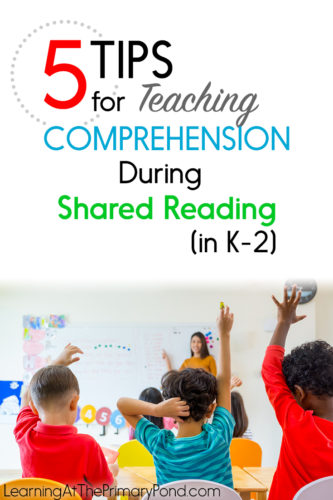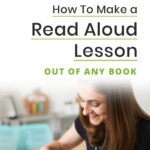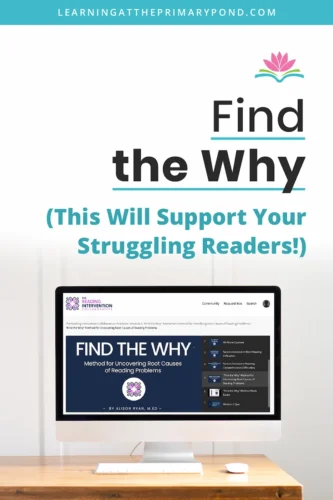Any time we read a book with students, comprehension is a priority!
However, comprehension instruction and practice take different forms, depending on the type of instructional activity we are doing. In today’s post, I focus on how to address comprehension during shared reading activities.
Photo Credits: weedezign, Shutterstock
1. The first time you read a text, focus primarily on comprehension.
As I explained in previous shared reading posts, I usually reread a shared reading text several times with my students.
There are so many different things that can be taught with just one text—fluency strategies, decoding strategies, sight words, print concepts, phonics patterns…the list goes on!
However, it’s too much to try to squeeze ALL of that into one read! (That’s why rereading is so valuable.)
The first time we read the text, my goal is simply for students to UNDERSTAND it. I usually read the shared reading text all the way through during the first read. (During subsequent reads, I usually focus only on a part of the text at a time.)
During this first read, I might model or have students assist me in using a comprehension strategy (i.e., making predictions or activating background knowledge prior to reading). I also do some thinkalouds, saying things like:
- “Right now I’m thinking…”
- “I’m wondering…”
- “I predict…”
- “I infer…”
At the same time, I try not to make the shared reading experience too “teacher-talk heavy.” I do some modeling, sure, but I also have students actively participate by asking them to share what they are thinking, make predictions with a partner, share prior knowledge and new learnings, retell the text after we finish reading, and so on.
Typically the only other thing we do during that first reading is a little decoding work (because the words are new to the students, this is a great time for me to model a decoding strategy and/or have them help me choose a decoding strategy to figure out a tricky word). This decoding work is quick, since our focus is comprehension.
2. Save many of your higher-order thinking questions for your rereads.
During our first read of a shared reading text, I ask some literal comprehension questions to get students thinking and see if they are understanding the text. I may ask a higher-order thinking question as well.
However, many of my kids will be more successful with answering higher-order thinking questions after they’ve heard the text more than once. So I make sure to ask 1-2 of these types of questions every time we reread the text.
Here are a few examples of questions I ask:
- If you were the main character, how would you have solved the problem?
- How can you take what we learned from this text and use it in real life?
- What would you add to this text?
- What was the most important part? Why?
- What does the author think about this topic? How do you know?
If you get in the habit of asking 1-2 of these questions each time you read your shared reading text, it will a) get students comfortable with answering these questions, b) provide support through multiple rereads, and c) remind you to address comprehension in some way each time you read the text—even if your main teaching point is something different, like fluency or decoding.
3. Remember to actually TEACH comprehension strategies, rather than just asking questions.
Asking students questions is an important part of shared reading (or any reading experience). But when we ask a comprehension question, we are mostly trying to find out if students comprehended the text.
We have to ALSO teach them HOW to comprehend the text in the first place! This is where comprehension strategy instruction comes in.
Some examples of comprehension strategies are:
- Make predictions before you read and while you read
- Ask questions and read to find the answers
- Figure out who the most important characters are
- Stop periodically and make sure you understand what the author is saying
- If you get confused, reread the last paragraph / page
These are things that we want our students to do during shared reading AND on their own. Shared reading is a great time to introduce strategies, model them, and help students as they try them out with the shared reading text.
4. Have students participate in the meaning-making process as much as possible!
Although teaching comprehension strategies is a “must,” we don’t want shared reading to be all about teacher talk and modeling.
If you think about the gradual release of responsibility, shared reading falls somewhere in between a readaloud and guided reading. In a readaloud, we do the vast majority of the work. In guided reading, students do most of the work. So shared reading is somewhere in-between.
To achieve this balance, I usually do a little modeling earlier in a lesson and then have students help me practice afterward. Here are some simple ways to get students to actively participate in the shared reading experience (these work for teaching comprehension as well as other strategies):
- Think-Pair-Share (students talk with a partner before you call on 1-2 students to share out)
- Sticky note writing (pass out sticky notes and pencils before the lesson and choose a few places where students will draw or write to share their ideas)
- Select a student leader or two (have a student come up to the front of the class and be the teacher, demonstrating a strategy that he/she recommends for the text)
- Ask open-ended, broad questions (“What are you thinking right now?” “What are you wondering about?” “What strategy should we try?” “How can we check to make sure we understand this text?”)
5. Find fun ways for your students to demonstrate their comprehension of the text!
I’ll go more in-depth on shared reading extension activities in a future post, but here are a few ways that students might demonstrate their comprehension. Some of these can be done whole-group, but many of these ideas also make great activities for literacy centers or Daily 5:
- Act out the text (whole class or small groups; can be done with/without props or puppets)
- Create a page to add to the text
- Create a brief video to share information / ideas from the text
- Write a sequel or prequel to the text
- Write a play or Reader’s Theatre piece based on the text
Conclusions
If you’re looking for more guidance in teaching comprehension during shared reading, check out my NEW Flexible Shared Reading Units for Reading Workshop! These lessons are for K, 1st, and 2nd, and they provide book and activity ideas for teaching comprehension (and many other strategies) during shared reading.
Happy teaching!













What do you do when students are constantly complaining about rereading a book?
Great question! I try to handle that right away at the beginning of the year by explaining that we reread a book for different reasons. Each time we reread a text, I start the activity by telling kids what we’re going to be thinking about / looking for during this reread. Also, I try to be picky about books and find texts that will truly interest my kids. We sometimes do 2 texts per week if they are shorter.
I hope this helps a little!
Alison